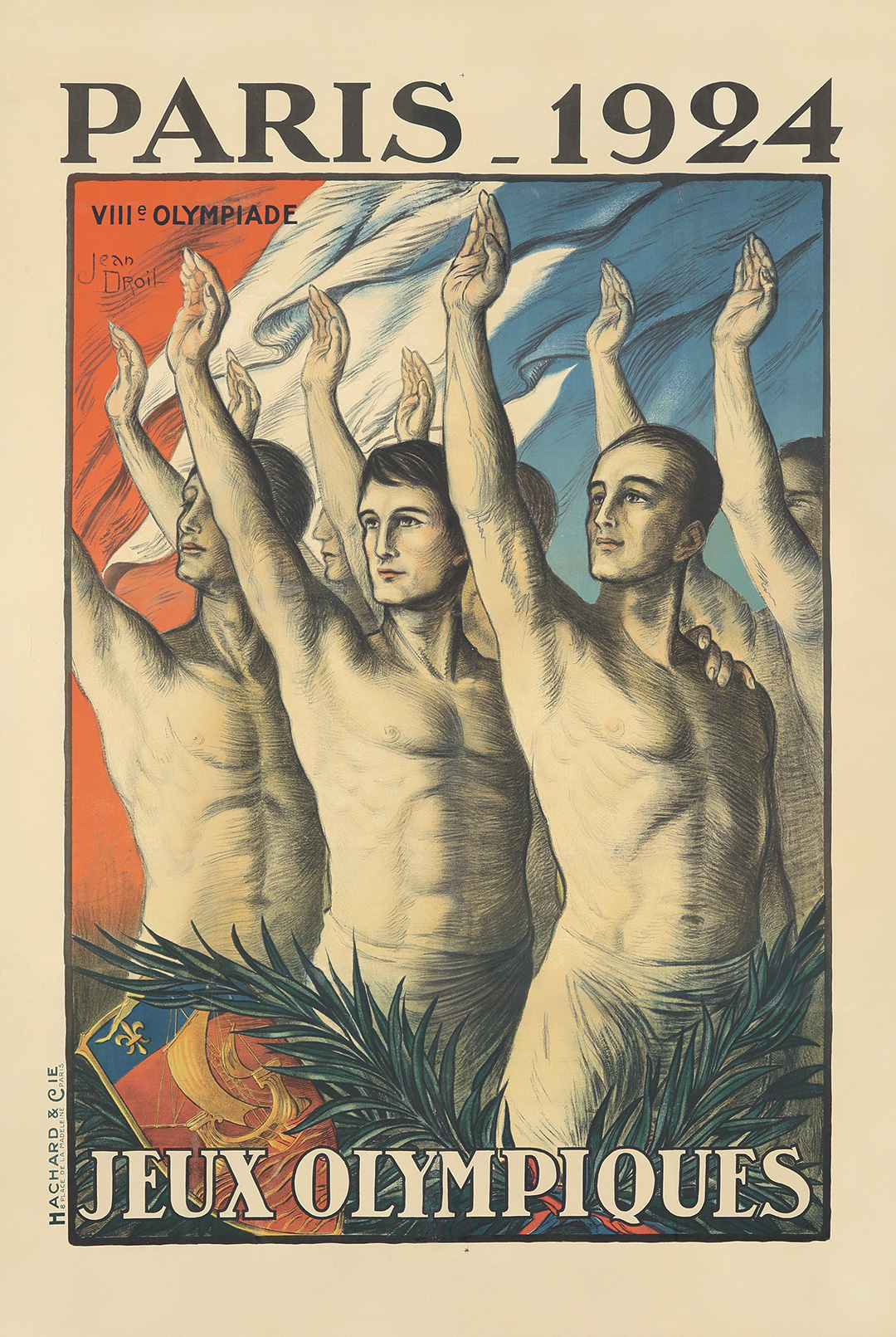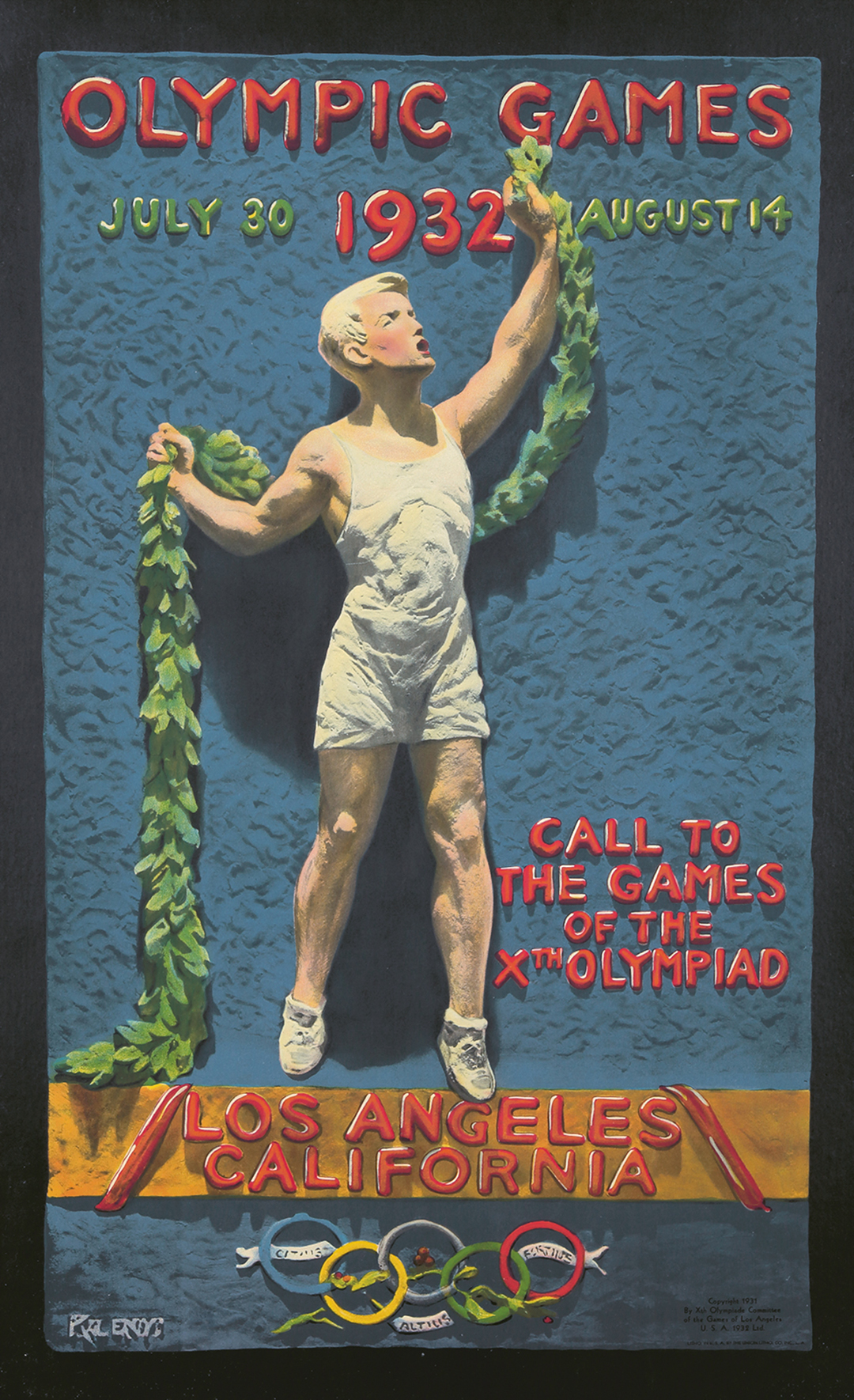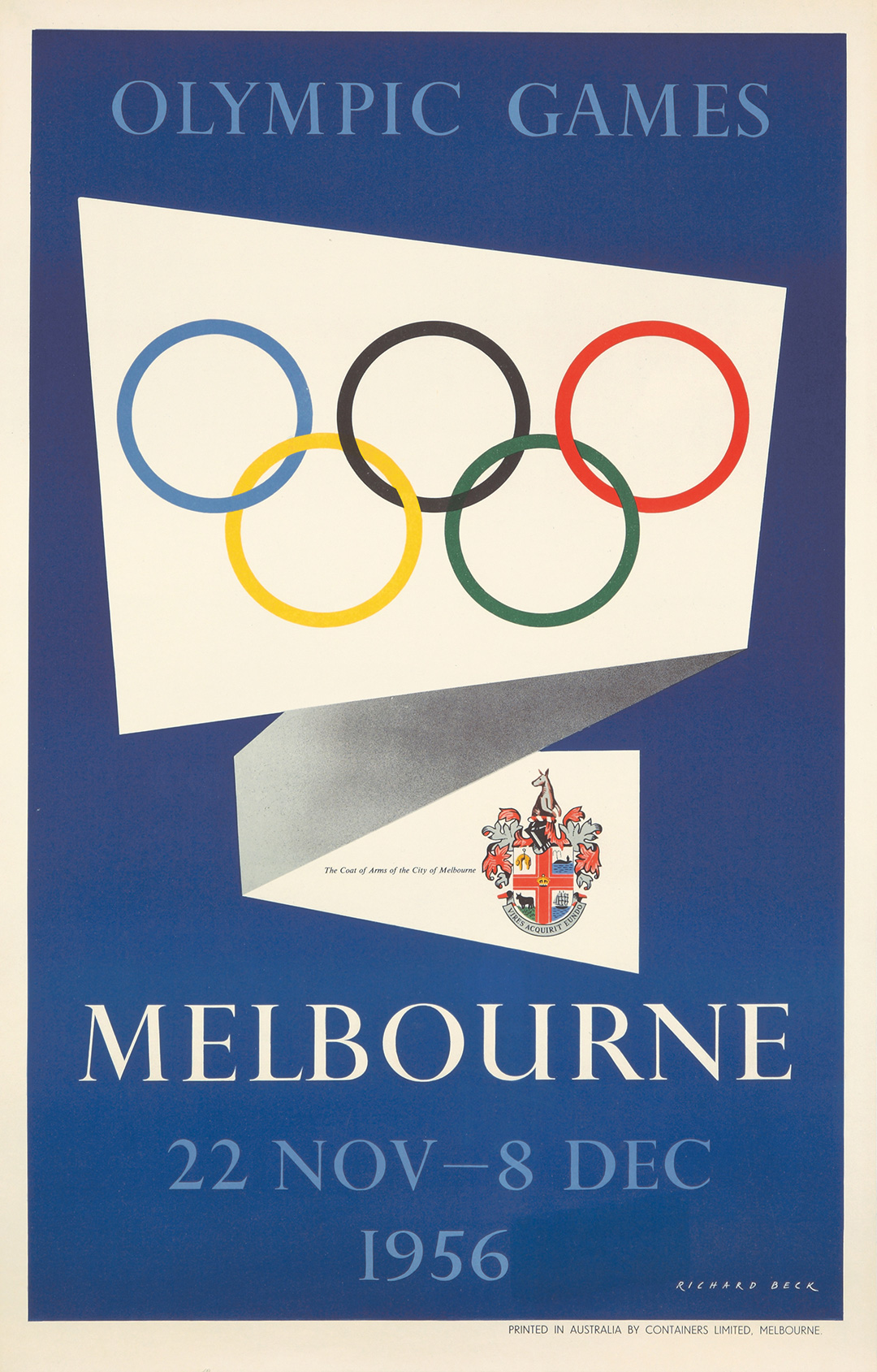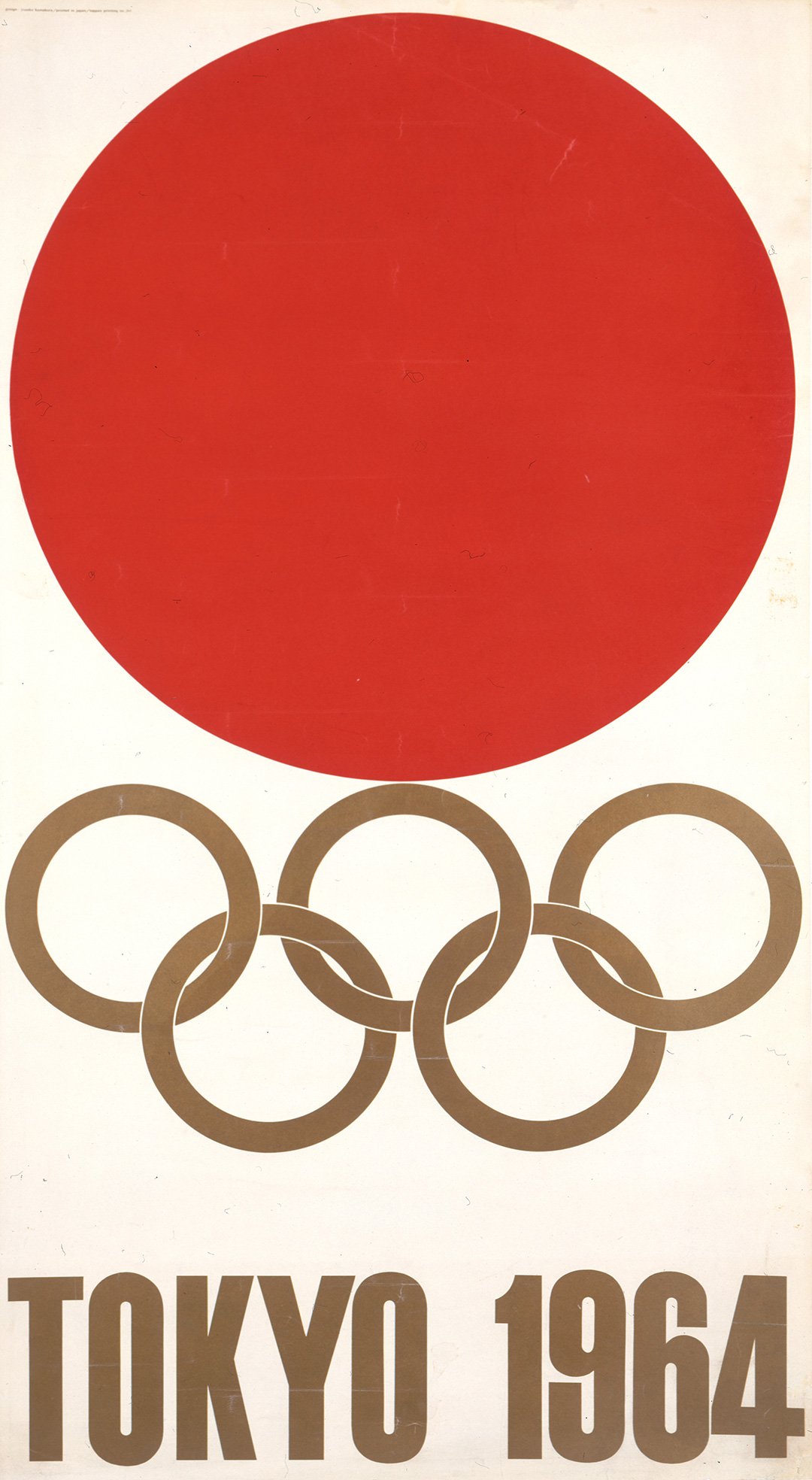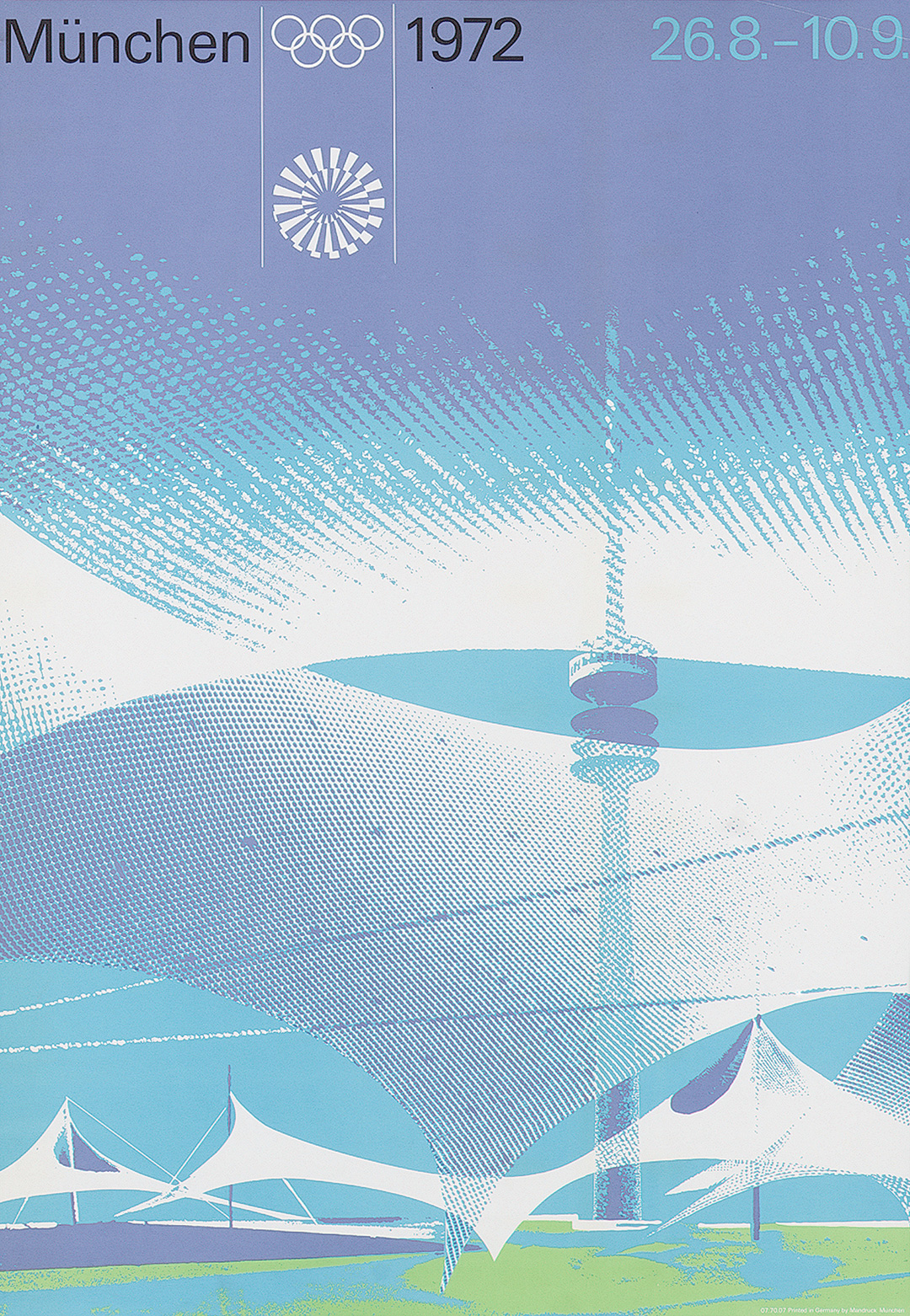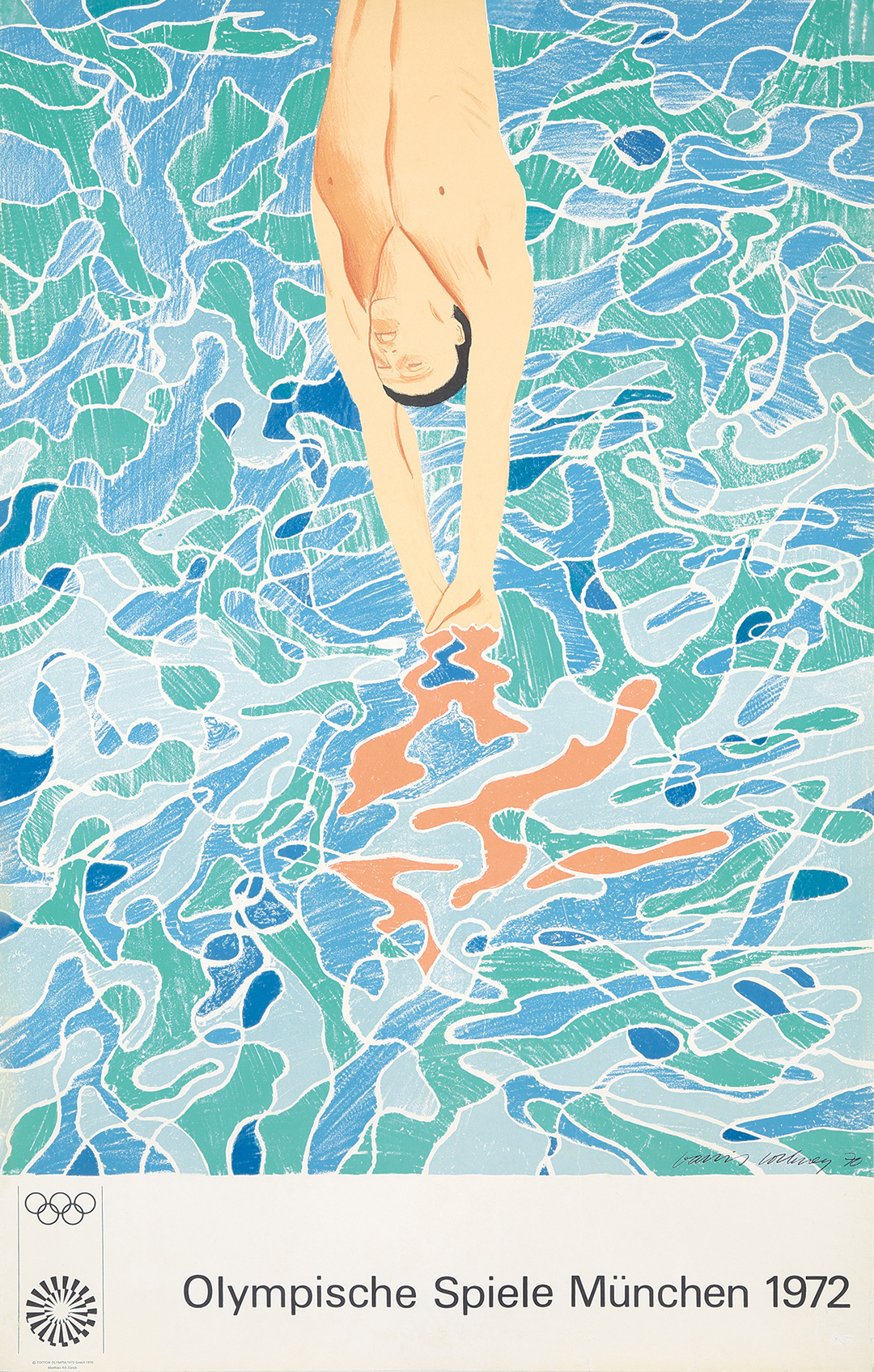Poster Art of the Summer Olympics
With the Tokyo Olympics underway, the timing is ripe for a bit of athletic reminiscing. Since 1896, the modern-day Summer Olympics have provided an opportunity for the world to come together and bask in the awesome feats of the human body. This great sporting event needed promoting, of course—and one of the wonders of our 50,000-image Poster Archive is that we have a nearly complete record of all the Summer Olympics posters in history. Here is a selection:
Although there was no official poster produced for the first ever modern Olympic Games in Athens, this cover image from the Official Report became the design associated with the event. Paying homage to the first ancient Olympic Games in 776 BC, the scene includes several nods to Antiquity: the goddess Athena holds a foliage crown, which was awarded as the highest prize at the Panhellenic Games. She also holds a branch, referencing the 1896 awards for first place (an olive branch) and second place (a laurel branch). Behind her, we glimpse the Acropolis and the Panathenaic Stadium, which played hosts to the Games. For this event in 1896, the stadium was restored and became a major highlight of the Games.
Highlights: American James Connolly won the first gold medal of the competition with a winning triple jump.
The second modern Olympic Games was actually a rather loose collection of international competitions recognized by the Olympic committee and held in conjunction with the 1900 World Exposition in Paris. Posters were created for athletics, rowing, cycling, gymnastics, and, here, fencing. We see a woman fencer flourishing the three traditional weapons: foil, épée, and saber. In fact, women were not to enter the fencing events until 1924—but try telling that to Pal, who aimed comely female figures at his viewers’ hearts as unerringly as if they wore the target seen on this costume.
Highlights: This year introduced rugby, golf, cricket, equestrian events, archery, and soccer to the Olympic Games. This also marks the first year that women could participate. American Alvin Kraenzlein won gold in four track and field events.
This year’s Olympic Games also did not have an official poster, but rather used this image from the daily program cover for promotion. The Olympic events were combined with the World’s Fair / Louisiana Purchase Exposition. The design uses Art Nouveau details to frame a view of the city of St. Louis, where events unfolded over several months.
Highlights: Newly added sports include freestyle wrestling, the decathlon, boxing, and dumbbells. American gymnast George Eyser, who had a wooden leg, won three gold medals and six medals overall.
Still in their infancy, the fourth Olympics attracted 22 nations and a little more than 2,000 participants. The games went on for a marathon three months at London’s Shepherd’s Bush, where the swimming pool at Stadium Center was bordered by the cinder track. The new organization could muster only an illustrated program; this design—a cooperative effort of the French and British railways—is the only known poster for these games. Subdued but intense, it is dominated by a runner straining so hard for the winning laurel that he practically leaps into our laps.
Highlights: Field hockey, indoor tennis, and motorboating were added to the events. And for the first time, swimming and diving competitions were held in a pool.
The Games of the Fifth Olympiad saw the birth of the first official poster for the events. Held in Stockholm, a nude Swedish athlete brandishes his country’s flag in the foreground, an orange streamer artistically covering his modesty. Behind him in equally enthusiastic procession are male athletes from other countries, each with his respective flag. This poster was printed in 16 languages and three size variants, of which this is the largest, German text version.
Highlights: The great Jim Thorpe won dual gold medals in the decathlon (a record 8,413 points that stood for more than almost two decades) and the newly unveiled pentathlon. According to Olympic lore, Thorpe was the first to be dubbed the “Greatest Athlete in the World.” He was also the first Native American Olympic Gold medalist, though the IOC later, sadly, stripped him of his medals for a questionable amateur status.
“The official poster for the Antwerp 1920 [Olympic] Games… was executed by Walter van der Ven… A version of the image had previously been chosen by the provisional committee for the cover illustration of its 1914 brochure, thus explaining the poster’s slightly old-fashioned concept. It featured a discus thrower in the foreground, enveloped in a swirl of the flags of the participating nations… with the Belgian flag prominent to the left and the coat of arms of Antwerp displayed top right. A panoramic view of the city, showing the majestic towers of the Gothic cathedral of Our Lady, the Grote Markt and old City Hall, reinforced the message that Antwerp’s proud cultural heritage justified its selection as the venue for the VII Olympiad—a precursor of the many posters in the years to come that would project patriotic imagery and emblems of civic identity” (Olympic Posters, p. 31). This is the larger format, French text version of the poster.
This is the banner under which Harold Abrahams and Eric Liddell won the 400m and 100m events, as immortalized in the 1981 film “Chariots of Fire.” It’s the poster that symbolized Johnny Weissmuller’s swimming. And it’s the Olympics that first used the motto “Citius, Altius, Fortius” (Higher, Faster, Stronger). “The espousal of mass physical culture became a source of national pride and strength, as perfectly exemplified in Jean Droit’s image” (Olympic Posters, p. 35). This was one of two posters selected out of 150 entries; it’s become one of the world’s most cherished items of Olympic memorabilia.
The determined muscularity of Rover’s runner garnered him both the honor and five-hundred guilder purse promised by the Organizing Committee to the Dutch artists invited to create the official poster for the 1928 Amsterdam games. The stadium designed for the Olympiad by Jan Wils with its marathon tower provides the design’s majestic background. Though not visible in the poster, the top of the tower provided an appropriately regal home for the Olympic flame, which for the first time in the modern Games, burned throughout the length of the proceedings. Rover also reproduces the billowing flag with the five interlaced rings, designed by Coubertin, which had been approved at the Paris Congress of 1914. The rarest of all pre-World War II Olympic posters!
Highlights: Chicago-born, train-chasing Betty Robinson was one of the first great American track athletes. In only her second race—at age 16—she matched the world record in the 100 meters. In Amsterdam, she became the first woman to win the 100 at the Olympics, and also won a silver medal in the 4×100 relay race.
In the ancient Greek tradition, a young athlete was sent out to announce the forthcoming celebration of the Olympiad. For the 10th Olympics in Los Angeles, the artist modeled a likeness of that ancient Greek youth in clay; a photograph was taken, and then colored and reproduced by lithograph. Only a couple thousand copies were made, and this is the only one we have seen.
The official design for the 1936 Olympics in Berlin shows the city’s Brandenburg Gate silhouetted against the golden image of an athlete wearing a triumphant crown of laurel. The poster, sponsored by the German railways, was printed in nineteen languages and allegedly distributed in thirty-four countries. Here we see the English-language version.
Highlights: Jesse Owens cemented himself as America’s—if not the world’s—greatest track athlete of his time. He won 4 gold medals in Berlin, which earned him the credit of “single-handedly crushing Hitler’s myth of Aryan supremacy,” according to ESPN reporter Larry Schwartz.
July 19 - August 3, 1952
By the time World War II broke out in Europe in 1939, preparations had been completed for the scheduled 1940 Olympiad in Helsinki, including this official poster chosen in competition from among 72 Finnish artists. When the war forced the event to be canceled, Helsinki had to wait until 1952 to host the Games, and it was decided to use the old poster, substituting only the new dates. The design depicts a bronze statue (by Waimo Aaltonen) of the most famous Finnish athlete—Olympic runner Paavo Nurmi— together with a globe on which the location of Finland is highlighted. This is the larger format of the poster with English text.
The first Olympiad after World War II was held, fittingly, in the town that had suffered grievous losses during the long ordeal but emerged victorious. There was only one official poster, by an artist who escaped from Nazism in 1939 and settled permanently in England; at this time, he was the art director of Heros Publicity Studios in London. The poster was printed in three sizes, of which this is the medium format. It gives the story in perfect shorthand: the Grecian athletic spirit meets the British Houses of Parliament.
Highlights: The United States had a stellar diving team and swept the three medal spots in both the men’s and the women’s 3-meter springboard event.
The 1956 Melbourne Summer Olympics were the first to be held outside of Europe and North America, as well as the first held in the Southern Hemisphere. This meant that the events occurred during the Northern Hemisphere’s winter.
The official (and only) poster for the 1960 Olympics held in Rome was chosen from 212 designs submitted in a nationwide competition held three years in advance. The wolf that allegedly weaned Romulus and Remus is the symbol chosen to represent Italy; in the center, the winning athlete is putting on his crown, according to Roman custom.
Highlights: This was the year of Muhammad Ali. He claimed the gold medal in the light-heavyweight division, but this feat still did not earn him access to a segregated restaurant back home. Purportedly, he threw his medal into a river in a fit of anger. 36 years later, he received a replacement medal and was invited to light the cauldron at the 1996 Games in Atlanta, which he said was one of his greatest honors. And Abebe Bikila from Ethiopia became the first Black African to win Olympic gold with a world-record marathon time. To boot, he ran in bare feet, which is how he was trained.
Up until 1960, the custom was to have one official design for each Olympiad, plus one or at most two alternates for each separate event (like the Winter Games). For the 1964 Tokyo Olympics, Kamekura and his team prepared four posters of equal standing. This official poster features the rising sun over the interlocking rings; the image coincidentally became the symbol of the 1964 games. “The artist managed to connect the simplicity originating from Japanese tradition, pureness of composition and ultramodern graphic design… The whole [series] was designed in a form of homogeneous ideogram created to announce a distinguished happening. The synthetic manner of communication became an inspiration for other designers, in order for each Olympic games, besides the particular poster, to have their own visual identification in the form of an easily accessible sign, its own logo” (Atheny-Atlanta, p. 16).
Highlights: Soviet gymnast Larisa Latynina won six medals in the 1964 Summer Games, giving her a then-record 18 medals—nine of them gold—over three Olympics. Only Michael Phelps has won more Olympic medals.
Perhaps the most memorable of all Olympics posters, this image upped the graphic design ante with bold and nearly transfixing graphics. Blending influences from Op-Art, the international style, Huichol Indian art, and Aztec carvings, the branding pays homage to Mexico’s cultural history while positioning it as a modern urban center. Wyman and Murdoch developed the imagery by mirroring the Olympic rings in the typography; the addition of rippling lines creates a vibrational Psychedelic effect. The central logo seen here—the official poster for the event—was used throughout their design work on more posters, signage, postage stamps, sculptures, et al. The overall motto of their work was “information, aesthetics, functionalism,” and, to this day, their work is heralded as a breakthrough in the possibilities of graphic design for wayfinding, public information, and aesthetics.
Highlights: American athletes Tommie Smith and John Carlos raised their fists and hung their heads while the U.S. National Anthem played during their medal ceremony at the 1968 Summer Games. Their gesture became front-page news around the world as a symbol of the struggle for civil rights. By their side stood Australian Peter Norman, who expressed his support by wearing an Olympic Project for Human Rights badge.
This is the official poster of the Munich Olympiad of 1972, designed by Otl Aicher, who served as the art director of the event. Aicher stylizes the tent-shaped roof of the stadium and the Olympic tower; beneath the logo, the coil symbol—which acted as the official emblem—represents the sun and also the five Olympic rings merged in a spiral shape.
He also commissioned separate posters for each of the twenty-two sports in the competition. Among the designers were Otte Hesse, Erich Baumann, Peter Cornelius, Albrecht Gaebele, and others. In order to create a unity of style, Aicher specified that all the individual sport posters start with a photograph, which was then solarized to achieve unusual effects and printed in bright color combinations.
Similar to the breakthrough of the Mexico Olympics graphic design, Otl Aicher’s work had a ripple effect in the world of graphic design. Most famously, Aicher developed a set of pictograms to help navigate visitors and athletes from around the world; the simple representational shapes could be visually understood with no need for translation. These pictograms inspired the U.S. Department of Transportation to create their own series in 1974, which were further adopted by companies around the world.
Highlights: Before Michael Phelps, there was Mark Spitz. He won seven swimming events at the 1972 Summer Games. It was the most golds won at one Olympics until Phelps won eight in 2008.
One of the greatest British artists of the 20th century, David Hockney fell in love with California and moved to Los Angeles in 1964. His 1967 masterpiece A Bigger Splash, part of the Tate Gallery’s permanent collection, elevated the swimming pool into one of the major motifs of his life. For the 1972 Munich Olympics, the perfect verticality of the diver comes into joyous contact with seemingly every permutation of shape and form that water can take, forming a mosaic of patterns, chaos, and precision. But swimming, not diving, turned out to be the epic tale of the ’72 Olympic pool, as American Mark Spitz won 7 gold medals and set 7 world records.
This graphic abstract shape represents the Games’ mascot whose nickname was Amik, a word of the Algonquin language meaning “beaver.” The prism of light beaming across the animal combines the colors of the Olympics rings (used in another official poster), and can be seen in several other designs promoting the Games. This use of color and graphics creates a synthetic harmony across the Games’ branding system.
Highlights: Nadia Comaneci became the first gymnast in Olympic history to score a perfect 10 in an event—and she did it seven times at the 1976 Olympics. The Romanian, who collected three golds in Montreal, finished with three 10s on the balance beam and four on the uneven bars. Bruce Jenner—now Caitlyn Jenner—won the 1976 Olympic Decathlon with a then-record score, earning the title of “World’s Greatest Athlete.” In the midst of the Cold War era, this win helped the U.S. reclaim its dominance in the event.
This 3-sheet Moscow cityscape was no doubt intended to facilitate pedestrian traffic in the Russian metropolis by providing a guide to those unfamiliar with the city’s landmarks. It also features “the emblem of the Games (which) was chosen from 26,000 sketches provided by 8,500 designers. It breaks down into three elements: the five rings, the track of a stadium and the five pointed star placed above” (Olympics, p. 120). Woefully, this colorfully nifty map was not seen by many Western eyes at the time of the Olympics as a result of the Russian invasion of Afghanistan and the ensuing United States-led boycott of the Moscow Games.
Better known for her wax and latex sculptures, and for her then-shocking nude advertisement in the November 1974 issue of Artforum, Benglis created this abstracted design of the Olympic rings for the 1984 Summer Games held in Los Angeles.
Highlights: Carl Lewis won the Gold for the men’s 100 meters in the 1984 Olympics. Considered one of the greatest track and field athletes of all time, Lewis won the 100, 200, and long jump, and helped win gold in the 4×100. He won a total of ten medals over four Olympics. And “America’s Sweetheart” Mary Lou Retton had one of the most memorable individual performances in Olympic history. A made-for-prime-time moment, Retton rallied to become the first American woman to win the Olympic gymnastics all-around title. She did it with a banged-up knee and perfect 10s in her final two exercises.
For the 24th Olympiad held in Seoul, Korean designer Yang Seung-choon created the official emblem of the games, a convolute pattern in blue, red, and orange above the interlocking Olympic rings in metallic gold. A wide gold border and black type bring it all together. Cho Young-Jae designed a photomontage, see here, which features a white-clad torchbearer with the rings in white exploding into blue and red.
Highlights: Florence Griffith Joyner, aka “Flo-Jo,” dominated the 100 and 200 meters, setting a world record in the 200 (21.34 seconds) that still stands today.
All of Spain’s top graphic artists participated in this series of twenty-seven posters that glorify Barcelona’s Olympic participation with colorful and imaginative designs. More conceptual in nature, the moods vary from playful to thoughtful in equally far ranging styles and media. Though this design was not used as the main poster for the event, we Americans are quite partial to the dynamic motion of our Michael Jordan as he leaps off into outer space.
Highlights: Team USA basketball “Dream Team,” led by Michael Jordan, Larry Bird, and Magic Johnson, dominated and won the gold.
The Atlanta Games were commemorated by Angeli with this silk-screened, hand-signed, officially sanctioned design that combines classic figure study with modernist, color-block flair. These were far and away the largest modern era games ever held with a record 197 nations competing. These Olympics had some of the best Olympic stories ever: Muhammad Ali’s return to the global stage as he ignited the Olympic cauldron; Kerri Strugg’s hobbled, gutsy final vault; and the horror of a terrorist bomb ripping apart a peaceful Friday evening in the Centennial Olympic Park, reminding the world of the tragedy of Munich in 1972. But as they did in ‘72, the games would go on, propelled by the fierce beauty of professional athleticism.
Highlights: American Michael Johnson set a new world record in the 200 meters, finishing in 19.32 seconds.
Referencing Australian boomerangs, the designers created this image of the Millennium Man, who also acted as the emblem of the Games. The white flash above him represents the smoke from the Olympic torch as well as the peaks of the famous Sydney Opera House, which is featured again at the bottom of the image. Behind him, we see his shadow in the form of a human athlete.
Highlights: Venus Williams won the singles gold before teaming up with sister Serena to win the doubles gold for the United States.
The olive branch of the ancient Games is brought back to life for the 2004 events. It was not only the first place award of 1896, but the olive tree is also the symbol of ancient Athens as well as of peace. Here, the open circle acts as an invitation for unity in the home of the historic games.
The overarching theme of the posters for the 2008 Olympics was “One World, One Dream,” within which three concepts were explored: “Green Games,” “High-Tech Games,” and “People’s Games.” This design employs the Forbidden City and the Temple of Heaven to reference China’s historic landmarks. Another iteration of this design focuses on the country’s modern architecture: the National Stadium—known as the Bird’s Nest—and the National Aquatics Centre.
Highlights: Michael Phelps won a record-setting eight gold medals. Usain Bolt set the world record in the 100-meter & 200-meter final.
Part of a series to attract French tourists to the Games, this image uses a tongue-in-cheek interpretation of classical Greek sculpture. But here, our athletic God is a portly Brit who’s taking a stab at some pub games after drinking a few pints. Using models, the artists then rendered their photographs in digital 3D. Though the English got a good kick out of these images, the posters were not displayed in the UK.
Highlights: McKayla Maroney’s reaction on the podium after winning the silver medal became the most viral moments of the games. Gabby Douglas became the first African-American female gymnast to win the Olympic individual all-around.
Special thanks to Yardbarker, CNN, and History.com for Olympic Game highlights throughout the years.








